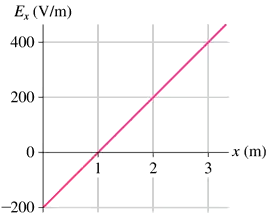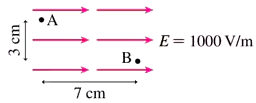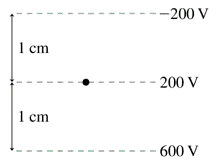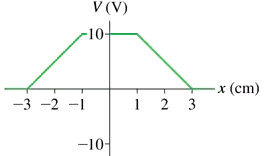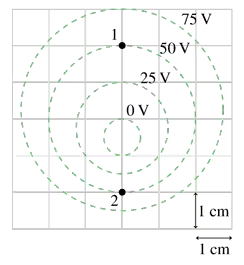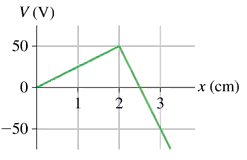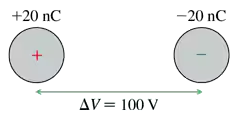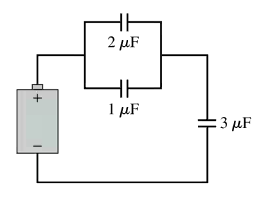 Back
BackProblem 2
What is the potential difference between xi = 10 cm and xf = 30 cm in the uniform electric field Ex=1000 V/m?
Problem 3
FIGURE EX26.3 is a graph of Ex. What is the potential difference between xi=1.0 m and xf=3.0 m?
Problem 5a
Which point in FIGURE EX26.5, A or B, has a larger electric potential?
Problem 5b
What is the potential difference between A and B?
Problem 6
What are the magnitude and direction of the electric field at the dot in FIGURE EX26.6?
Problem 8
FIGURE EX26.8 shows a graph of V versus x in a region of space. The potential is independent of y and z. What is Ex at (a) x=−2 cm, (b) x=0 cm, and (c) x=2 cm?
Problem 9
Determine the magnitude and direction of the electric field at points 1 and 2 in FIGURE EX26.9.
Problem 10
A −2.0 V equipotential surface and a +2.0 V equipotential surface are 1.0 mm apart. What is the electric field strength at a point halfway between the two surfaces?
Problem 12
FIGURE EX26.12 is a graph of V versus x. Draw the corresponding graph of Ex versus x.
Problem 14
What is the potential difference ΔV34 in FIGURE EX26.14?
Problem 15
The electric potential along the x-axis is V = 100x2 V, where x is in meters. What is Ex at (a) x=0 m and (b) x=1 m?
Problem 17
How much charge does a 9.0 V battery transfer from the negative to the positive terminal while doing 27 J of work?
Problem 19
Light from the sun allows a solar cell to move electrons from the positive to the negative terminal, doing 2.4×10−19 J of work per electron. What is the emf of this solar cell?
Problem 21a
Two 3.0-cm-diameter aluminum electrodes are spaced 0.50 mm apart. The electrodes are connected to a 100 V battery. What is the capacitance?
Problem 21b
Two 3.0-cm-diameter aluminum electrodes are spaced 0.50 mm apart. The electrodes are connected to a 100 V battery. What is the magnitude of the charge on each electrode?
Problem 22
What is the capacitance of the two metal spheres shown in FIGURE EX26.22?
Problem 24
A switch that connects a battery to a 10 μF capacitor is closed. Several seconds later you find that the capacitor plates are charged to ±30 μC. What is the emf of the battery?
Problem 25
A 6 μF capacitor, a 10 μF capacitor, and a 16 μF capacitor are connected in series. What is their equivalent capacitance?
Problem 27
What is the equivalent capacitance of the three capacitors in FIGURE EX26.27?
Problem 29
You need a capacitance of 50 μF, but you don't happen to have a 50 μF capacitor. You do have a 75 μF capacitor. What additional capacitor do you need to produce a total capacitance of 50 μF? Should you join the two capacitors in parallel or in series?
Problem 32
A 2.0-cm-diameter parallel-plate capacitor with a spacing of 0.50 mm is charged to 200 V. What are (a) the total energy stored in the electric field and (b) the energy density?
Problem 33
50 pJ of energy is stored in a 2.0 cm×2.0 cm×2.0 cm region of uniform electric field. What is the electric field strength?
Problem 38b
The electric field in a region of space is Ex=5000x V/m , where x is in meters. Find an expression for the potential V at position x. As a reference, let V=0 V at the origin.
Problem 39a
The electric field in a region of space is Ex = −1000x^2 V/m, where x is in meters. Graph Ex versus x over the region −1 m ≤ x ≤1 m.
Problem 39b
The electric field in a region of space is Ex = −1000x2 V/m, where x is in meters. What is the potential difference between xi = −20 cm and xf = 30 cm?
Problem 40
An infinitely long cylinder of radius R has linear charge density λ. The potential on the surface of the cylinder is V0, and the electric field outside the cylinder is Er = λ/2πϵ0r . Find the potential relative to the surface at a point that is distance r from the axis, assuming r>R.
Problem 43
Use the on-axis potential of a charged disk from Chapter 25 to find the on-axis electric field of a charged disk.
Problem 44
Engineers discover that the electric potential between two electrodes can be modeled as V(x)=V0ln(1+x/d) , where V0 is a constant, x is the distance from the first electrode in the direction of the second, and d is the distance between the electrodes. What is the electric field strength midway between the electrodes?
Problem 45
The electric potential in a region of space is V=(150x2 − 200y2)V, where x and y are in meters. What are the strength and direction of the electric field at (x, y)=(2.0 m, 2.0 m)? Give the direction as an angle cw or ccw (specify which) from the positive x-axis.
Problem 48
The electric field in a region of space is V/m , where x and y are in m. The zero of electric potential is at the origin. What are (a) the electric field and (b) the electric potential at the point (x,y)=(2.0 m, 1.0 m)? Hint: The potential difference is the same along any path connecting two points.

